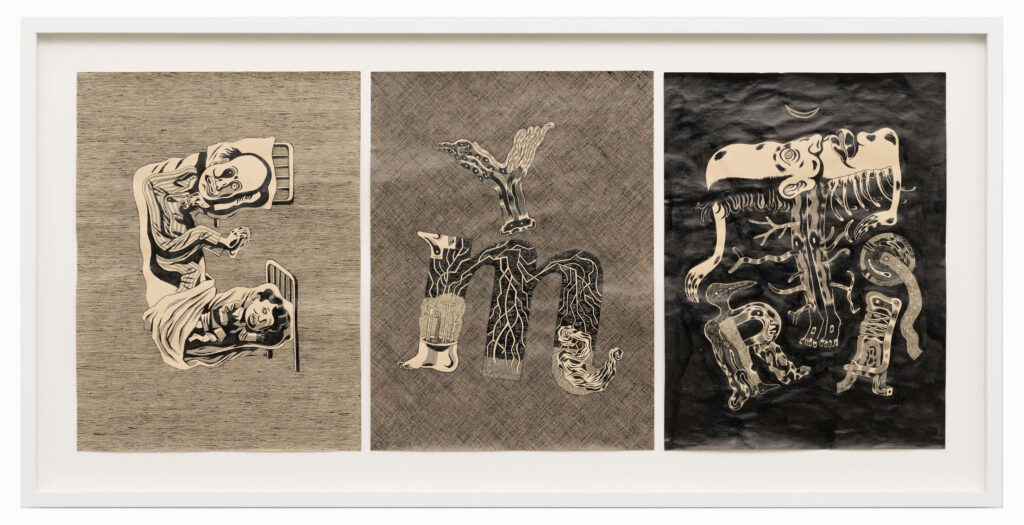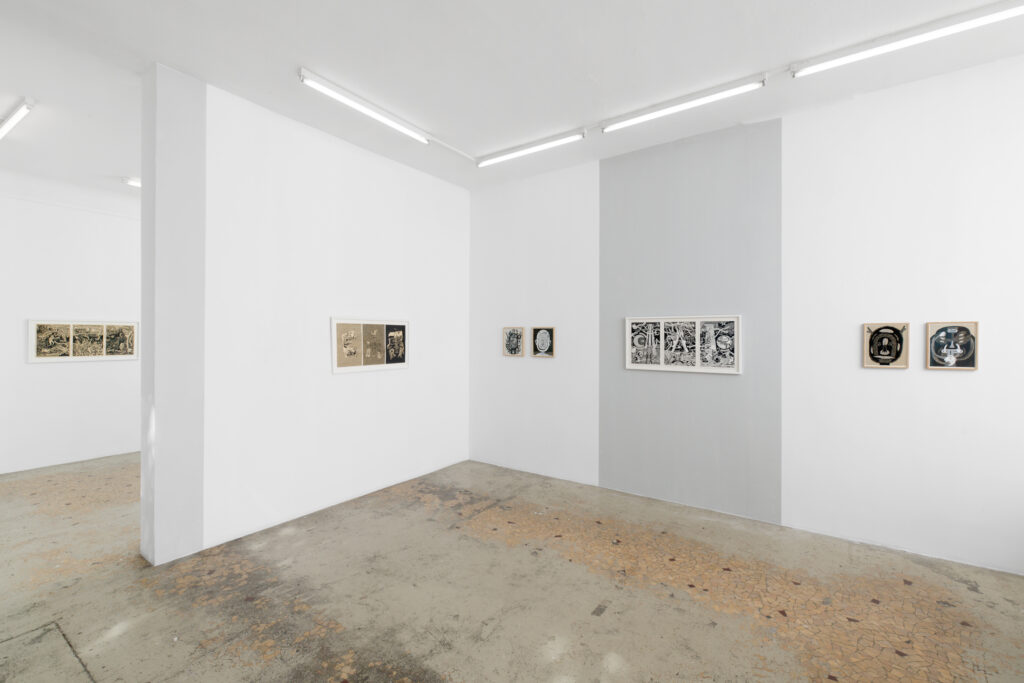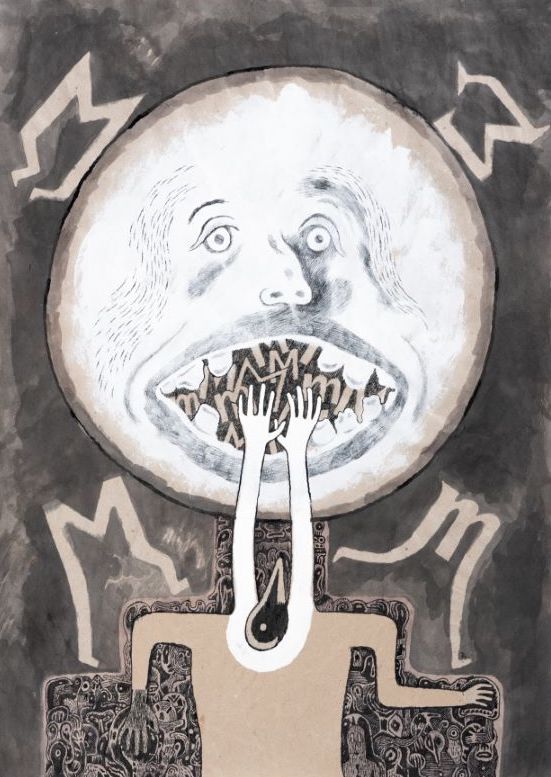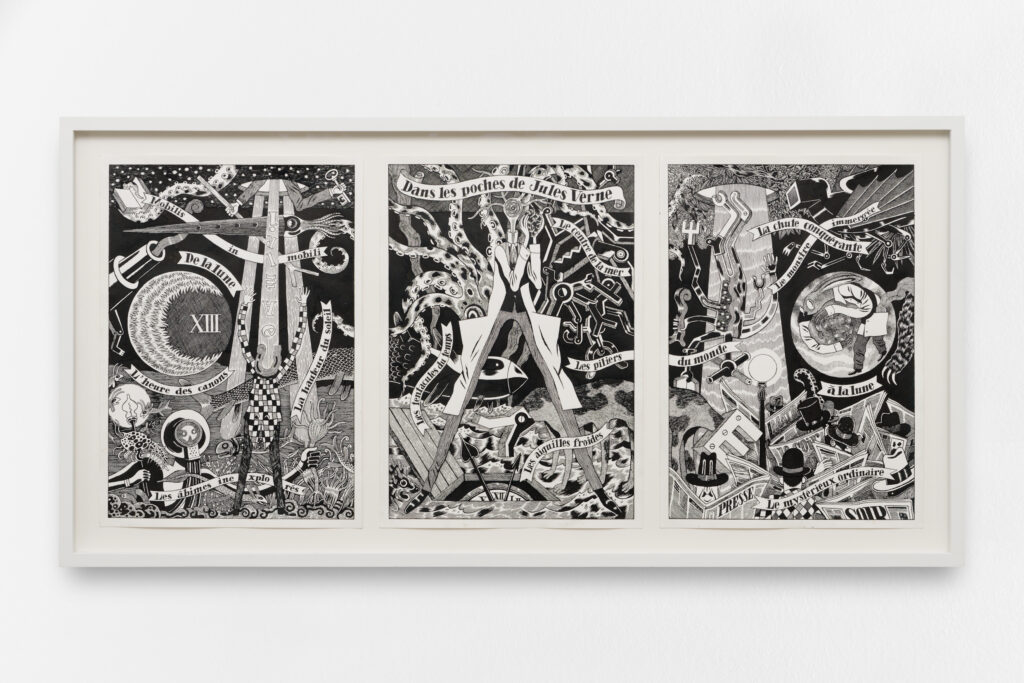For his fourth solo exhibition at galerie anne barrault, David B. pursues a long-term quest that began with L’Ascension du Haut Mal. In this autobiographical tale, published in six volumes between 1996 and 2003, David B. retraced the evolution of his brother Jean-Christophe’s epilepsy and its impact on his family. He also analysed the gradual unfolding of his own creative work. Real-life stories were interwoven with imaginary characters and dreamlike narratives; David B.’s world, including relentless heroes and protective, benevolent creatures, was torn between the forces of consciousness and unconsciousness, the rational and the irrational, balance and chaos.

David B.
L’invention de l’écriture, 2024
ink on paper
39 x 29,5 cm (x3)
A dozen years later, invited by Anne Barrault to create a different form of narrative in her gallery, David B. resumed his research on his brother, whose health was deteriorating. He wanted to “draw something that would represent all [his] brother’s crises one by one, drawing them one after the other”[1]. Spread over 72 drawings, the exhibition “Mon Frère et le roi du monde” (My Brother and the King of the World) confronts 36 portraits of his brother with 36 portraits of the “King of the World” (created by René Guénon in an eponymous book). These two walls of 36 drawings create links between the works in a variety of ways. They blur the boundaries between good and evil, right and wrong, today and yesterday, inside and outside.
Haunted by the recent death of his brother at the end of 2023, David B. has embarked on a new series of drawings about his sibling. “It’s what comes naturally to me, the desire to draw him, what he was, what he did, what he didn’t do. To bring him to life, in a way.”[1] These vivid recent memories from the last night David B. spent with his brother are marked by a spoken and sung monologue, incomprehensible – like a luminous and serene agony. Unanswered questions remain about how his older brother, gradually deprived of part of his memory and the use of a language, might feel. In these drawings, it is his brother’s body that takes centre stage. “The body is very important because my brother’s body has been very much affected. His illness, his epileptic seizures and the fact that he fell and hurt himself.” A body damaged by falls and medication, dislocated from the inside, fragmented, losing its usual connections. This “brother in pieces” that David B. draws, he has “often seen it as if each fall shattered a piece of him”. But it’s also a body that reads, attached to words – those in his mother’s books, those he speaks, and the new language he creates. A triptych deals with “The invention of writing”, and letters emerge from bodies.
David B. has lived in Bologna for several years, where he produced this series of drawings. He uses and mixes ink, gouache, acrylic and pencil, in his favourite black, white and grey palette. He paints and draws on a variety of papers, some of which have been salvaged and cut to the 30 x 40 cm format (that of the comic strips, and of what can be easily transported): it’s a question of adapting to their absorption and dilution capacities. These drawings are developed over a long period of time, even though the project is laid out in advance, in a notebook, in the form of a rough matrix. The future drawings are sketched boxes with titles; “often I start with the title, and I find a drawing that corresponds to a title”. There are several titles per page, and you can navigate through this notebook like in a gallery of paintings, or like in a slightly abstract storyboard, where reading the titles builds an enigmatic story. David B. cultivates the need to let himself be guided by the creative process, doing touch-ups, if necessary, that gradually come together: “I do everything directly on the final page, which doesn’t mean I work quickly, I think a lot. If it doesn’t work, I erase it and come back to it. I paint over it. It’s hardly surprising, then, to find in his current acquaintances two important figures of the surrealist movement, the French painter André Masson (whom he rediscovered as told by Michel Leiris), and the Italian writer, painter and brother of Georgio Di Chirico, Alberto Savinio. Here words and singular works of art, some of them little-known, come together to build worlds out of things that don’t exist together. David B. draws us into this revelation of the invisible through his ability to transcribe an imaginary world of incredible fertility, tainted of tragedy.
Camille de Singly
April 2024
[1] Translatred from Mon Frère et le Roi du Monde, L’Association 2016.
[2] This and the following quotes are taken from an unpublished interview with David B. on 5 March 2024.

David B.
Mon frère en morceaux, 2024
ink on paper
39,5 x 39,5 cm

David B’s exhibition view, 2024 (photo Aurélien Mole)

David B.
Bar Bar, 2024
ink, gouache, acrylic, pencil on paper
42 x 29,5 cm / 53,5 x 41 cm framed

David B.
Dans les poches de Jules Verne, 2024
ink on paper
42 x 30 cm (x3) / 101,5 x 51 cm framed
 David B.
David B.Mon frère et ses amis, 2024
ink, gouache, acrylic, pencil on paper
41 x 51 cm framed
